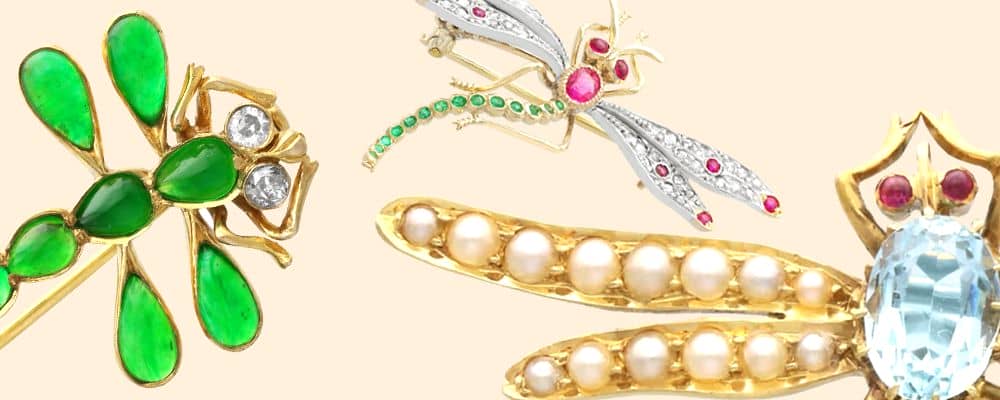Dragonfly Jewellery
Antique and Vintage Dragonfly Jewellery for Sale
Explore our stunning collection of antique and vintage dragonfly jewellery for sale. Our collection includes stunning gemstone and diamond dragonfly brooches.
All dragonfly jewellery purchases will arrive gift wrapped with a complementary insurance valuation and will include free global shipping.
Andrew Campbell, using his 40 years’ experience within the antique jewellery industry, handpicks all vintage and antique jewellery for sale.

Dragonfly Jewellery Frequently Asked Questions
In 8th century Japan, the dragonfly was linked in myth to the rice plant, considered a bringer of rich harvests. Perhaps these ancient origins are why dragonflies were such a popular option for insect jewellery, closely linked to power and prosperity, they were almost destined for greatness.
Like many insects, dragonflies undergo a significant change over the course of their lives, and only exist as we picture them for a small period in their lifetime. For this reason, dragonflies are viewed in many cultures around the world as a symbol for change, as well as an icon of embracing change, making change into a positive thing that one can face. Perhaps due to their size and speed, dragonflies are also often linked to strength. They are powerful insects with a bold appearance, making them a logical motif for those looking to epitomise power also.
For some, dragonflies symbolise a powerful determination also. Not only are they large and intimidating as far as the insect world, but they also have the capability to bite humans. Although dragonflies are not venomous, and so pose no similar threat to similar creatures such as some spiders, their general ferocity is commendable and makes them a desirable design for many.
Japonism – from the French ‘Japonisme’ – is a term for the phenomenon of Western art and design taking influence from Japan. In 1858, trade was reopened between Japan and the West, and this is where the advent of Japonism can first be found. Everything from architecture to jewellery can be found being influenced by Japonism. The dragonfly had been a common motif in Japanese design since the 8th century, and it transferred to the Western world largely through the use of cloissoné enamel. Japanese cloissoné enamel was at its peak at the turn of the 20th century, allowing for more detailed and innovative designs that had previously been possible.
Dragonfly jewellery had been made in Britain during the Victorian period, usually from gold and heavy-set with gemstones. These designs have great beauty, but do not accurately convey the true movement of the insect. With Japonism involved, however, enamelling was used during the Art Nouveau period to create intricate, more delicate designs that celebrated the agility and dexterity of dragonflies. At a time when sweeping, curving shapes were the epitome of fashion and grace, dragonflies became a highly popular element of jewellery.
Plique-á-Jour enamelling advanced jeweller’s abilities to properly depict the dragonfly, and allowed for the delicate veins and subtle details of dragonfly wings to be created with a high level of precision. The way in which the wings were attached to the body of the piece evolved also, allowing it to appear as though the dragonfly was merely hovering nearby for a moment or two, before they would be sure to move along. The dragonfly motif had nature and metamorphosis in its image, making it potentially the epitome of design in the Art Nouveau period.
After Art Nouveau fell out of fashion, Art Deco took its place. A stark contrast was created between the elongated, sweeping movements of Art Nouveau, which took its inspiration from nature, Art Deco was oriented around sharp, geometric lines and symmetrical patterns. As could be predicted, dragonfly jewellery – as well as most other insect jewellery – was largely left at the wayside from this point onwards. Today, insect jewellery is mostly admired by collectors, although it is seeing a gradual rise in popularity thanks to influences like Lady Hale and her infamous spider brooch.







